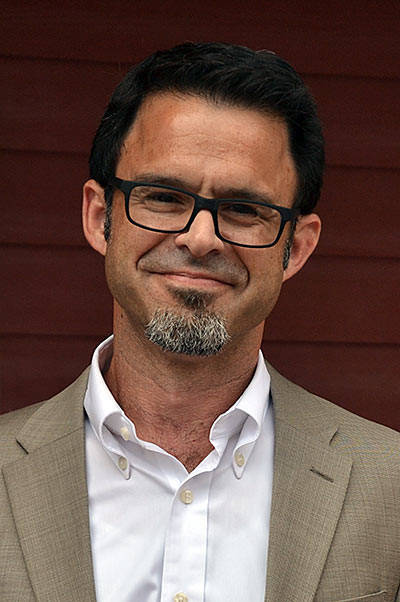
 |
| Mural designed by Kari Johnson and painted by Sponsors’ clients, staff and volunteers |
In 2012, Roger Fields was staring homelessness in the face. Fields was three weeks away from being released from the Oregon State Correctional Institution, where he had served 22 months of a 31-month stretch stemming from convictions for car theft, drug possession and a parole violation.
“I have family out here, but you sort of burn bridges at times,” Fields says. Fields, 53, says he would have been “on the street” if not for his third application to Sponsors, Inc., the Lane County-based nonprofit that provides housing opportunities and help with employment, education and other services for people with a criminal record.
Sponsors accepted his application at the last minute, Fields says. After his release, he began his reentry into society by staying at one of Sponsors’ short-term living facilities while he got back on his feet.
Via its housing program, Sponsors provides Lane County with 150 beds spread among 13 buildings on six sites, and the nonprofit serves 300 to 400 people annually, says Paul Solomon, the group’s executive director. “With our reentry resource center and our employment program, we probably serve closer to 1,000 people,” he says.
 |
| Paul Solomon, executive director of Sponsors |
Solomon notes that Sponsors serves anyone in Lane County with a criminal record. Sponsors also offers a relatively new program specifically for women and children. The program, called Reunification in a Supportive Environment, launched in 2013 and provides housing for up to five families on any given night.
“To my knowledge there is no other reentry program in Oregon as comprehensive as Sponsors [providing] such a broad range of wrap-around services,” Solomon says.
With a state award of $9 million in tax credits, Sponsors and the Housing and Community Services Agency of Lane County (HACSA) are set to move forward jointly on a new 54-unit housing development in west Eugene called The Oaks at 14th. This development will help Sponsors’ clients in need of longer-term housing. Residents can stay for two to three years if necessary, rather than the three to four months clients usually stay with Sponsors before making the transition to independence.
The Oaks at 14th is “a very ambitious and exciting project that we are planning on breaking ground on around the beginning of next year, and [construction] will take approximately a year to complete,” Solomon says. The Oaks at 14th is especially needed because “there just isn’t enough housing in the community,” he adds.
The current housing market is tough for those with clean records, but if you have a criminal history, it’s that much harder to compete. Solomon says many property managers won’t rent to people who have convictions, which limits their ability to find places to live once out of prison.
For those looking for a clean start, the difficulty of finding a place to live disrupts their efforts at the very beginning of their journey.
HITTING ROCK BOTTOM
Fields says he was originally in Sponsors 15 years ago: “I went in and out of there so I knew it was always available. Most people who come out of Lane County know … that Sponsors is an option. I had applied from prison; my first two were denied, and I was persistent. I kept trying because I know [the situation] changes at all times and I was accepted a few weeks before I got out.”
Fields was born in Oroville, California, but has spent the majority of his life living in Lane County ever since coming up to Oregon with his mother in 1969. Fields says he “didn’t start getting into trouble until later on in his years” and that he has been to jail many times — but in 2009, at the age of 48, it all caught up with him.
The day before he turned himself in to go to prison, Fields was sitting in his oldest daughter’s apartment. “It was dark and I was watching TV alone, thinking, ‘What happened?’” Fields says. “I was making $50,000 a year and now I have nothing, zero, nobody.” Fields also lost custody of his children when he was sent to prison.
Fields describes his experience of going to prison as “hitting rock bottom.” Throughout the years, he says, “I have hit several bottoms, and rebounded back from them, but this last time I really hit bottom and I came out with a pair of work boots.”
Founded more than 40 years ago by a group of activists and Catholic nuns, Sponsors has 30 FTE employees and a $2.8 million budget, Solomon says. “The truth is we operate on a pretty thin dime, with an administrative overhead of 7 percent.”
According to Solomon, sources of funding for Sponsors include contracts with Lane County and the state of Oregon; the Department of Justice; United Way and FEMA; as well as numerous foundation grants and private donations. A number of buildings also generate rental income where Sponsors’ clients pay rent at a reduced rate.
Sponsors’ programs have been shown to reduce recidivism by between 30 to 50 percent, with 65 to 75 percent of Sponsors clients completing the program. Completion is contingent upon a client finding sustainable housing; having a legitimate source of income; complying with any parole conditions; passing all drug tests; and completing any programming required of them while staying with Sponsors.
Entry into Sponsors is very competitive, with beds regularly booked six to 12 months in advance, Solomon says. He adds that acceptance into the program depends on how long a person has been locked up, as well as what their “risk score is.” The higher the risk, the more likely Sponsors is to accept the application.
While housing is an important aspect of what Sponsors provides in Lane County, there is more to it than just housing, Fields says. “Sponsors is great for resources. They offer you shelter and a safe space. They offer you resources for jobs, a bus pass, getting your ID back.”
COLLATERAL CONSEQUENCES
Fields’ near run-in with homelessness is not an isolated incident among the incarcerated. Once released, people who have successfully served their time enter the second phase of their punishment, where they experience what are known as collateral consequences. These include some of the biggest barriers to reentry for a person who is trying to turn his life around but is saddled with a criminal record.
The formerly imprisoned deal with sanctions, often mandated by law, that restrict where they can work and even where they can live. These additional obstacles put into place by virtue of a person’s criminal record are some of the biggest barriers to successful reentry.
“Folks with criminal histories are often screened out by landlords,” says Jacob Fox, executive director of Housing and Community Services Agency of Lane County (HACSA).
While it is true that those with a criminal record are not completely shut out of the housing market, their applications are accepted on a case-by-case basis, says Jim Straub, president of Acorn Property Management in Lane County. Straub, also legislative director for the Oregon Rental Housing Association (ORHA), says that “if someone has a history of rape or sex abuse, pedophilia, or a drug history or criminal history,” the association’s members may still consider the application.
Straub says he once rented to a person who spent 20 years in prison for murder. “He did his time, he wrote a letter, said ‘I’m a different person now,’ and it was an OK tenancy. He wasn’t an incredibly wonderful tenant, but he wasn’t horrible either.” But, he adds, if an applicant murdered a landlord, “then I might have a problem.”
Another consideration, Straub says, are letters from groups such as Sponsors vouching for their clients. But some crimes automatically blacklist prospective tenants. For example, Straub says that while other property owners and managers in the ORHA might make exceptions, he won’t rent to convicted rapists, and that it’s just a “decision I’ve made based on situations that have arisen in the past.”
Those with arson convictions on their record can find it particularly challenging to find housing. Due to federal regulations, Fox says, HACSA is unable to house those with an arson record, and Solomon says that Sponsors is unable to house them due to insurance issues.
A criminal record poses a daunting obstacle, and this reality is compounded by the fact that, according to Fox, there is also a lack of affordable housing in the area.
“Eugene, like a lot of communities across the state, needs more affordable housing,” Fox says. Eugene is a bit better off than other Oregon cities — Bend has a vacancy rate of 0.5 percent and Portland’s vacancy rate is around 3 percent, while Eugene’s rate hovers around 4 percent, according to the U.S. Department of Housing and Urban Development.
But, he adds, “when they do find housing, it’s often in the private market, and the rents are too high. It’s a really tough market. If folks coming out of jail or prison can’t find transitional or permanent housing, there is a huge percentage of folks that will become homeless.”
 |
| Roger Fields using the gym at Sponsors |
THE RISK OF THE STREETS
It’s tough to pin down exactly how many people are transitioning out of jail and into homelessness in Lane County. This is because, according to Sue Stahl, Lane County jail records supervisor, Lane County doesn’t “consistently collect that information to create a report that would be accurate” because even though there is a box to mark “transient,” the box is often left blank. “It’s not something that Lane County has made a requirement to track,” she says.
In fact, Lane County jail makes no effort to verify that the address supplied by inmates is accurate, Stahl says, adding that a person could “give me an address in the middle of the Willamette River” and it wouldn’t make a difference. For people released on parole, Lane County Parole and Probation investigates addresses.
Donovan Dumire, manager at Lane County Community Corrections, says that finding an exact figure for the number of people transitioning from Lane County custody to homelessness would be difficult. “Addresses often given could be a temporary address. It also depends on your definition of housing,” he says.
Dumire also notes that they work prior to release to guide people toward organizations such as Sponsors or the Eugene Mission in order to avoid having to release someone into a situation where they would have to sleep outside.
According to a 2013 report from the National Health Care for the Homeless Council, “incarceration and homelessness are mutual risk factors for each other.” The report also states that “researchers generally estimate that 25 to 50 percent of the homeless population has a history of incarceration,” noting that inmates were 7.5 to 11.3 times more likely to experience homelessness than the general population.
The Oregon Department of Corrections was able to supply some data relating to prisoner reentry but cautioned that its information system is “antiquated at best,” which “causes inconsistencies and entries that are out of our control” making it “impossible to compile accurate information on identified housing.” For example: between Aug. 1 and Nov. 1 of this year, 1,211 prisoners were released in Oregon, but 42 percent of them have “blank” listed as their housing type. Only seven prisoners, or 0.6 percent, are noted as homeless.
LOOKING FOR WORK
Finding housing is a huge barrier to reentry, but the other giant hurdle to overcome is finding a job. Without a job to pay the rent, minus hitting the lottery, a person might resort to committing a crime in order to obtain rent money.
When Fields got out of prison, he was able to leverage his experience as a drain technician to hit the ground running. He had a contact before he went to prison, and this person was able to secure a job for him upon his release. Through this job, Fields says he “sort of got lucky” and was able to impress one of the businesses he did work for as a drain technician.
They gave Fields a chance, and he made the most of it. To this day, Fields still rents a modest home and also lives with his second-youngest daughter, who is back in his custody.
While Fields has marketable job skills, others reentering society can have a harder time finding stability. “Maybe they’ve been locked up for 15 years and never worked a real job in their life,” Solomon says. “Our challenge is to sit down and develop a resume” and to “work with people on how to talk about their history in a job interview.”
Sponsors also works with employers to place clients in entry-level jobs that are mostly in the fields of landscaping, manufacturing and hospitality, Solomon says, adding that these businesses generally do not like to let on publicly that they are felony friendly.
Rather than simply trying to find jobs for those with a criminal history, Sponsors sets an example for others to follow because, according to Solomon, “approximately half of Sponsors’ staff are people with criminal histories.”
Being relegated to lower-paying jobs is a fact of life for many workers with no marketable skills and a criminal record. This puts these people in a tough position, resulting in former criminals going back to their old ways. “If I can’t find a job, I can’t find a place to live,” says UO sociology professor Randy Blazak, who studies white supremacist prison gangs. “I know how to survive. I’m going to go back to the drug trade or other illegal activity.”
He also refers to the blackballing of people with a criminal record as “the last legal form of discrimination.”
Blazak cites the case of a person he previously worked with. “He couldn’t get a job because of that box,” Blazak says, referring to the box on employment applications that job candidates must fill out regarding past criminal convictions. This man knew he could “make $1,000 a hit to beat someone severely.” The man did just that and wound up back in prison.
One way to help ease reentry, Blazak says, is by banning the box, and he says that doing so could reduce the amount of crime victims because former criminals will have less incentive to commit crimes to survive.
In November of this year, the Portland City Council unanimously passed a new set of rules regarding the box. These new rules, set to go into effect in July of next year, stipulate that many Portland business owners must wait until they’ve offered an applicant a job before inquiring about the applicant’s criminal record, according to The Oregonian.
Also in November, President Obama set a precedent at the federal level when he instructed federal agencies to ban the box. While this is helpful for now, the next president could easily nullify this directive.
BEYOND THE BOX
Banning the box is a start, and 19 states have, but this only “kicks the can down the road” because employers are still allowed to find the applicant’s criminal record “after already paying their debt,” says Karen Dolan, a senior fellow at the Institute for Policy Studies, based in Washington, D.C.
Dolan says the dialogue needs to shift toward expungement and suppression of records so that even relatively minor misdemeanor crimes, or even arrests not leading to conviction, don’t follow people their entire lives.
Another downside, according to Dolan, is the $65 billion reduction in the U.S. gross domestic product due to the lack of productivity from people prevented from working due to a criminal record. Dolan adds that one-third of people in the U.S. have a criminal record, and that these can stem from things as trivial as jumping over a metro turn-style or being involved in a political protest.
Dolan characterizes policies keeping people with a criminal record from working as “wrongheaded” and says that they are “not good for the incarcerated, not good for families or the community” and that it “doesn’t rehabilitate” while putting people into dire circumstances upon release.
“We can’t continue this way,” Dolan says. “Jails and halfway houses are overcrowded. It’s not a system that benefits anyone. It’s untenable.”
And besides, according to Dolan, after being out of jail for three years, the formerly incarcerated are no more likely to commit crimes than the general population.
The chair of Sponsors’ board of directors, Margaret Hallock, hints at things to come down the road, and writes that Sponsors plans “to be more active in state policy discussions about criminal justice reform. There is a better way, and effective reentry programs are part of the solution to the problems associated with mass incarceration.”
Here in Lane County, additional housing developments like the Oaks at 14th are a good start, giving hardworking people like Fields a second or even a third chance, if necessary. There’s still a long way to go before equity for this group of marginalized people is achieved, but for now, groups like Sponsors provide a safety net to those who get into the program.
“I don’t really know if I’d be here today if it weren’t for Sponsors,” Fields says. “I might have been headed in the same direction, but I wouldn’t be as far along as I am now, wouldn’t have vehicles, wouldn’t have my child back at home. I wouldn’t be living a clean life off of drugs.”